Classical CD Reviews: Andris Nelsons conducts Bruckner and Andrew Manze conducts Vaughan Williams
For all the surface-y beauty of the BSO’s playing, it’s a dull interpretation of Anton Bruckner’s Symphony no. 3. Andrew Manze’s Ralph Vaughan Williams is uneven.

By Jonathan Blumhofer
Where does one begin with Andris Nelsons’ new recording of Anton Bruckner’s Symphony no. 3 (1888/89 version), the first installment of a complete Bruckner symphony cycle he’s recording for Deutsche Grammophon with the Gewandhausorchester Leipzig? Perhaps by coming right out and saying that it occupies a special place: it is, perhaps, the most beautiful-sounding performance of a boring interpretation of Bruckner Three yet captured on disc.
Indeed, the Gewandhausorchester plays responsively and with tonal brilliance throughout. All of the imposing Bruckner qualities you might want to hear – the walls of sound, the somber mottos, the big paragraphs of ideas, the cathedral-like sense of sonic space – are apparent throughout this performance. But what’s missing is soul: there’re no hidden depths behind the music’s ponderous statements; no big reveal in the final, blazing coda. Quite the opposite, in fact. This is a reading that conspicuously lacks energy, excitement, and revelation.
At the heart of it, Nelsons’ conception of the piece seems to treat Bruckner’s Symphony as a relic, rather than as living, breathing music. Thus, for all the surface-y beauty of the orchestra’s playing, it’s a dull interpretation that plods, full of empty gestures and forced reverence.
Nearly everything sounds leaden, deliberate, and mannered. Take the fluctuations of tempo the score offers. What, for instance, is the difference between the first movement’s opening Tempo I (taken none too fast, to begin) and the development’s short, climactic Lebhaft? Or, more substantially, the second movement’s “Adagio (etwas bewegt) quasi andante” and subsequent “Andante (quasi Allegretto)”? It’s hard to say. Surely it has nothing to do with speed, character, or articulation. At least that’s what one is led to believe here, since, in both movements and under whatever marking, all those qualities sound pretty much the same.
Ditto for the Scherzo, which generally lacks momentum (though there’s some great viola section playing in the Trio) and swaths of the finale. At least the latter is partly redeemed by the amiable account of that movement’s second theme and the heroic brass chorale at the end – though, in the event, that grand coda isn’t really justified by what’s come before it.
The above issues carry over into other parts of the reading. What to do with the Symphony’s many dramatic pauses? Well, by about five minutes into the first movement, they’ve become vacant spaces, lacking tension or suspense, not a good sign in a sixty-minute-long score that has more than its share of them. Or the gracious, whimsical character of some of the subsidiary themes? Aside from the finale’s second motive, there’s little sense of charm or playfulness to be had here. Rather, everything’s serious and straight-faced. Which is a pity, because, even in this symphony, Bruckner can be as impish and good-natured a composer as they come.
Out of curiosity, I pulled the last Gewandhausorchester Bruckner cycle (which I reviewed for the Arts Fuse back in 2012) off the shelf to see how that Third, in particular, sounded in comparison to this one. Granted, that recording (led by a then-83-year old Herbert Blomstedt) is of the Symphony’s original version, full of Wagner quotes and with a totally different second movement. But in spirit and temperament, it’s Nelsons’ polar opposite: pulsing with energy, intensity, and passion. Those same qualities also shine through the two benchmark recordings of this final edition of the piece, Herbert von Karajan’s blistering 1980 disc with the Berlin Philharmonic and Giuseppe Sinopoli’s more intellectual 1990 account with the Staatskapelle Dresden.
Would that such accolades could greet this album. Here, though, it’s impossible to get around the fact that, as breathtakingly soft as the strings sometimes play, as remarkably balanced as the textures can get, and as lush as the woodwinds and brass sound, this is a reading that emphasizes, rather than minimizes, Bruckner’s longueurs.
Filling out the recording is an altogether pleasing performance of Wagner’s Tannhäuser Overture. You may recall that Nelsons’ first album with the Boston Symphony also ended with this piece. Taped in 2014, it was a dud: soft around the edges, flabby, and episodic.
This newer Tannhäuser, though only ten seconds or so faster, is far more fluent and better-paced than the last. The bacchanal remains a bit staid, but it’s brilliantly played. The “Pilgrim’s Hymn” moves with more direction and sounds altogether nobler. Nelsons tends to luxuriate in the sumptuous orchestral sonorities rather than emphasize the music’s drama, but, given the richness of the Gewandhausorchester’s sound, it’s hard to blame him for this indulgence. In the Bruckner, however, this tendency becomes an albatross.
Now, Nelsons can be a fine Bruckner conductor (he led a magnificent Sixth Symphony in Boston recently). And he can be a very spirited, emotionally engaged one, too, in concert and on disc (just listen to his Shostakovich series, also on DG). Unfortunately, you don’t get a full measure of either of those qualities here.

Andrew Manze seems to be just about everywhere these days, with fine new recordings of Elgar, Tchaikovsky, and Mendelssohn under his belt in the last year already. He’s also in the process of recording the complete symphonies of Ralph Vaughan Williams with the Royal Liverpool Philharmonic Orchestra (RLPO) for Onyx; the second volume, featuring the Symphonies nos. 3 and 4, is out now.
Both are stern works. The former, which Vaughan Williams somewhat misleadingly subtitled “A Pastoral Symphony,” draws on the composer’s harrowing experiences in the Great War. The Fourth is abstract, though its slashing motives and glowering orchestration jibe easily with the political and economic turbulence of the early-‘30s, when it was written.
In the present recording, the Third Symphony comes off the better of the two. It’s enigmatic music, unpredictable and unsettled, yet somehow familiar. Manze and the RLPO give free rein to the bleak lyricism of its first two movements. Rhys Owens turns in a haunting account of the second-movement trumpet cadenza. The third comes over as an austere respite and Andrew Staples delivers an affecting account of the vocalizations that open and close the finale.
As for the Fourth, it’s suitably big and brawny. But there are spots, especially in the outer movements, where a bit more drive and mania would pay dividends. As it stands, the music’s fury comes across a mite reserved.
Even so, there are intense moments in the first movement and a beautiful account of the second to be had. The Scherzo is wholly vital, full of fire and energy. If the finale isn’t quite at the same level as Bernstein or Colin Davis in this piece, well there’s some grand orchestra playing (highlighted by exuberantly agile low brass) to enjoy along the way.
Jonathan Blumhofer is a composer and violist who has been active in the greater Boston area since 2004. His music has received numerous awards and been performed by various ensembles, including the American Composers Orchestra, Kiev Philharmonic, Camerata Chicago, Xanthos Ensemble, and Juventas New Music Group. Since receiving his doctorate from Boston University in 2010, Jon has taught at Clark University, Worcester Polytechnic Institute, and online for the University of Phoenix, in addition to writing music criticism for the Worcester Telegram & Gazette.
Tagged: Andrew Manze, Andris Nelsons, Anton Bruckner’s Symphony no. 3, Boston Symphony Orchestra, Deutsche Grammophon, Onyx
